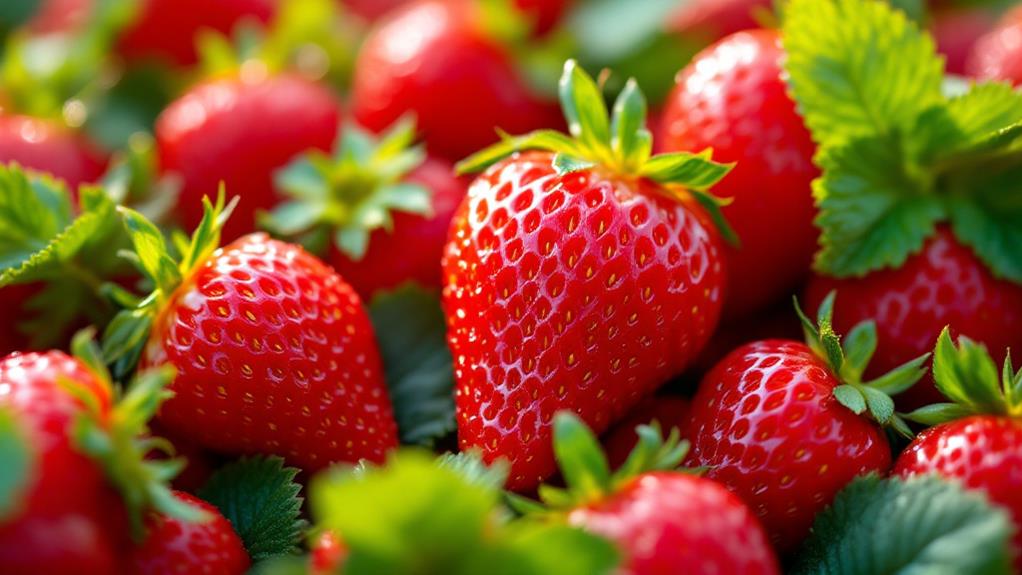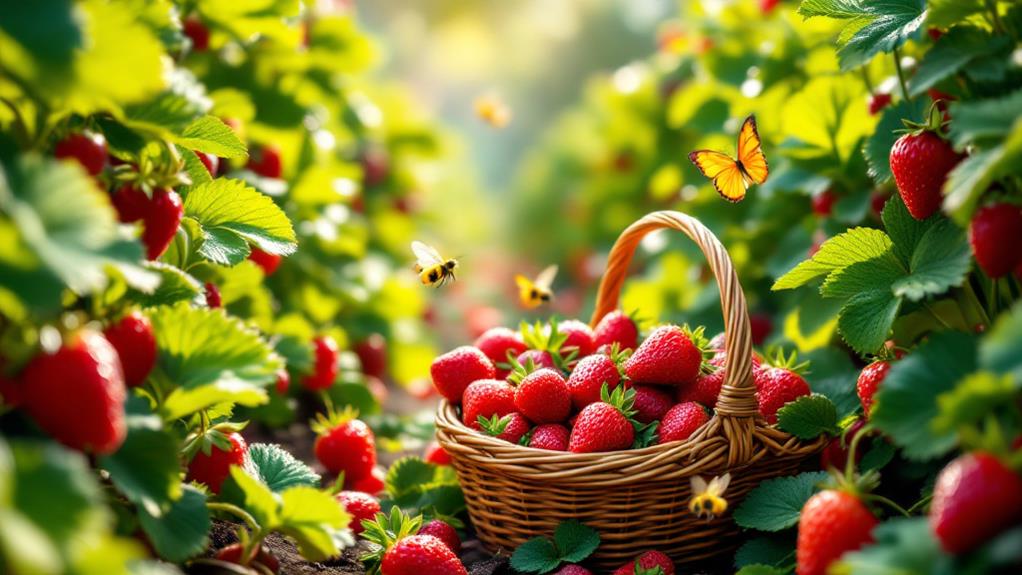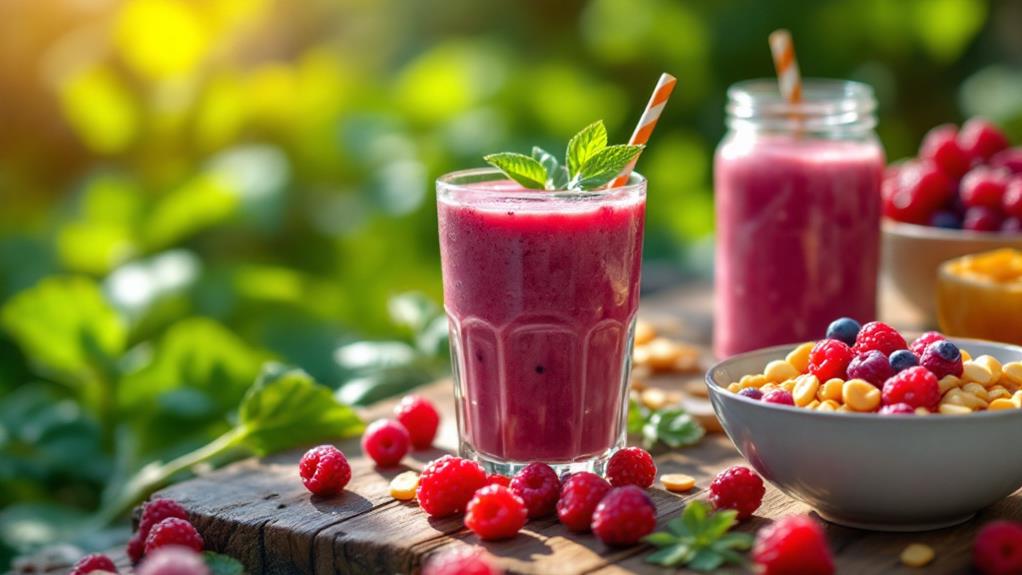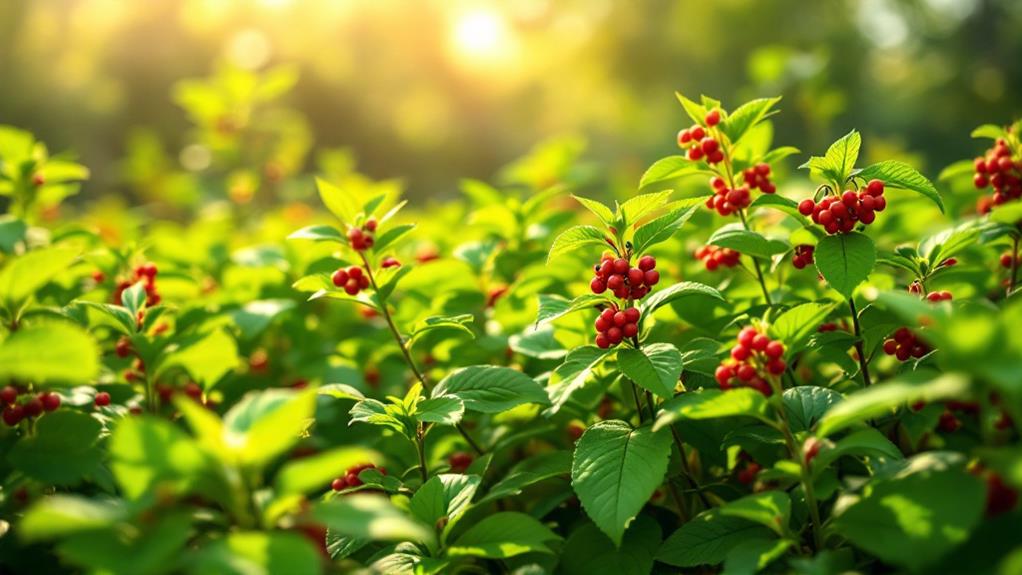Everything You Need to Know About Everbearing Strawberries
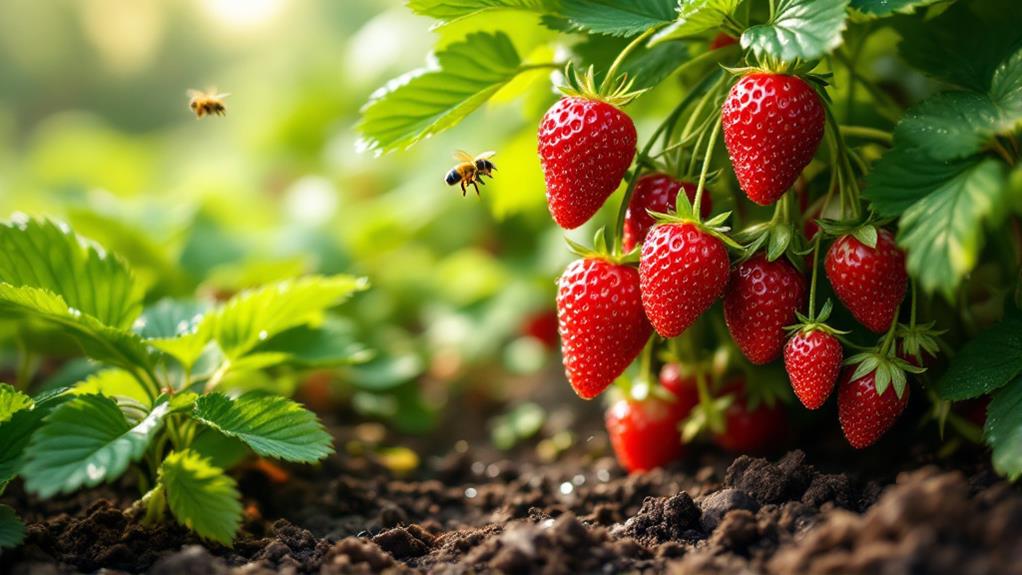
Everbearing strawberries let you savor fresh fruit from spring to fall with multiple harvests. They do well in USDA Zones 3-10 and prefer cooler climates. For best results, make certain the plants get six hours of sun daily and plant in rich, slightly acidic soil. Water them consistently, aiming for 1-2 inches per week. Pinching off runners helps focus energy on producing flavorful berries. When ripe, strawberries should be harvested every few days. With proper care and pest management, you can enjoy a bountiful yield. Interested in learning more tips on these rewarding plants? There's plenty to uncover about their benefits and varieties.
Understanding Everbearing Strawberries
Everbearing strawberries present a unique opportunity for gardeners seeking extended harvests throughout the growing season. Unlike June-bearing varieties, which only provide fruit in June, everbearing strawberries produce multiple harvests in spring, summer, and fall. This means you can enjoy fresh strawberries almost all season long. They thrive in USDA Hardiness Zones 3-10 and are influenced by cooler climates, making them adaptable to different environments.
True everbearing strawberries are different from day-neutral varieties because they flower and set fruit continuously, without strict day length requirements. This characteristic contributes to consistent fruit production, although the fruits are typically smaller than those from June-bearing plants. However, you'll find their flavor and sweetness can be improved with minimal drought stress and ideal growing conditions.
Be cautious of mislabeling when purchasing strawberry plants, as confusion between everbearing and other types is common. Knowing these specific characteristics can help you make informed decisions for your garden. By understanding everbearing strawberries, you're better equipped to cultivate a garden that offers delicious harvests throughout the season, ensuring a steady supply of fresh, homegrown strawberries for months.
Planting Techniques
Planting everbearing strawberries requires careful attention to timing and location for successful growth. Begin by planting in early spring or late summer when soil temperatures are consistently above 45°F to minimize transplant shock. Choose a site that receives at least six hours of full sunlight daily and features well-draining soil with a pH between 5.5 and 6.8 for peak growth.
When it comes to planting techniques, space your everbearing strawberries 15-20 inches apart to guarantee they have enough room. Dig holes twice as wide as the root ball to promote proper root development. Before planting, trim any dangling roots to encourage healthy growth. Improve the soil by incorporating 1-2 inches of well-aged compost. This step increases nutrient availability and enhances soil structure.
After planting, apply mulch around the plants, but be careful not to cover the crown. Mulching serves several purposes: it conserves moisture, suppresses weeds, and helps regulate soil temperature. This practice is crucial for moisture conservation and complete plant health. By following these guidelines, you'll set your everbearing strawberries up for a thriving season. Remember, attention to detail in these planting techniques makes all the difference.
Ideal Growing Conditions
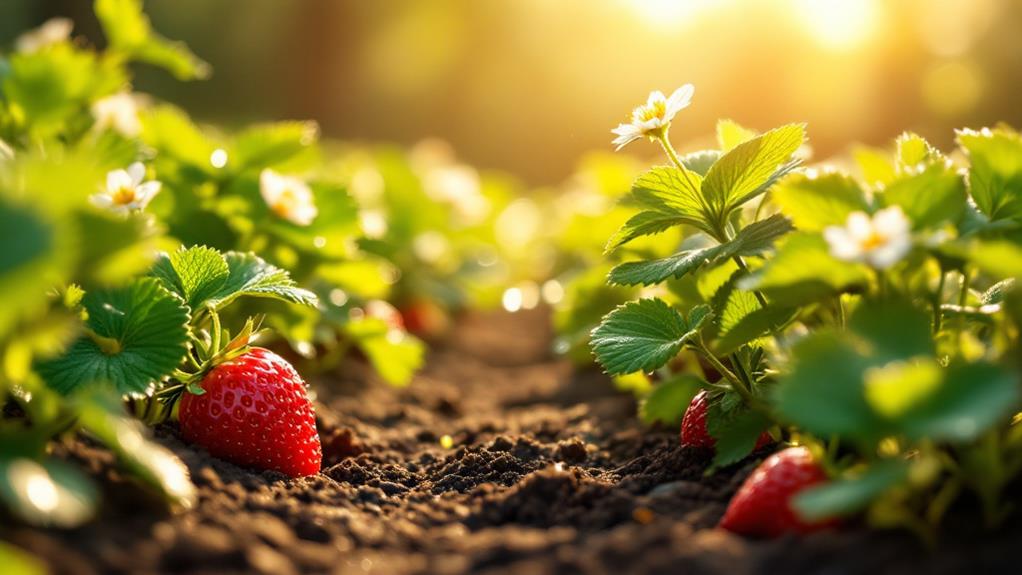
After getting your everbearing strawberries planted with care, it's important to focus on creating the ideal growing conditions for them to truly thrive. These strawberries flourish best in USDA Hardiness Zones 3-10, with a preference for cooler climates. To guarantee lively growth and a bountiful yield, you'll need to provide at least six hours of full sun daily. It's critical, however, to offer some protection from harsh afternoon sun to prevent stress on the plants.
The soil is another key factor. Aim for rich, well-drained soil with a slightly acidic pH level between 5.5 and 6.8. This environment supports root establishment and helps the strawberries absorb necessary nutrients. Consistent moisture is fundamental, requiring about 1-2 inches of water weekly. Be careful to maintain moisture levels without creating sogginess, as overly wet conditions can lead to root rot.
For the best results, plant your strawberries in early spring or late summer. This timing allows for root establishment and better resilience against colder temperatures. By focusing on these ideal growing conditions, you'll be setting your everbearing strawberries up for a successful and productive growing season.
Care and Maintenance
Caring for your everbearing strawberries is crucial to guarantee they remain healthy and productive. Start by confirming your plants receive at least 1 inch of water each week. However, be careful to prevent soggy soil, which can lead to root rot. To maintain moisture and control weeds, apply 1-2 inches of mulch around your plants. This will also help stabilize the soil temperature, promoting vigorous growth.
Regularly check the soil pH, aiming for a range between 5.5 and 6.8. Amending the soil with organic compost will provide the rich nutrients necessary for peak fruit production. Furthermore, improve the quality and yield of your fruit by pinching off long runners. This allows the plant to focus its energy on producing berries rather than extra growth.
Keep an eye out for common pests such as aphids and spider mites. Implement integrated pest management strategies to tackle these issues effectively, confirming that your strawberry plants remain healthy. This might include introducing beneficial insects or using organic sprays. By following these care and maintenance tips, you'll guarantee a bountiful harvest from your everbearing strawberries, maximizing their potential without compromising plant health.
Harvesting Tips
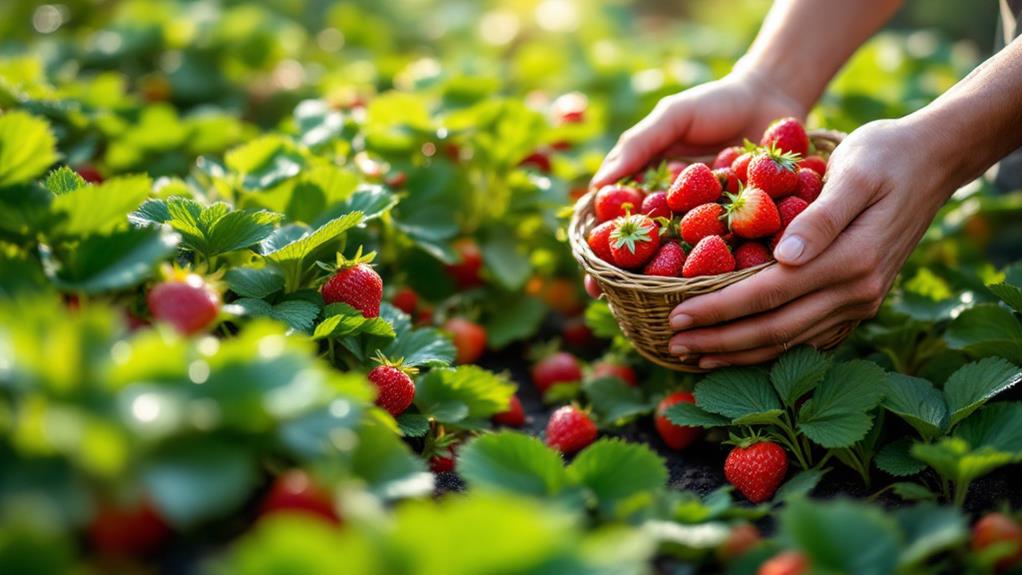
For the best flavor and sweetness, always harvest your everbearing strawberries when they're fully ripe, indicated by their bright red color and slight softness. Picking them at this stage guarantees you're getting the maximum taste and quality. During peak production, aim to harvest every two to three days. This frequent harvesting helps prevent overripening and potential rot, maximizing both the yield and quality of your berries.
To avoid damaging your plants, use a gentle twisting motion or scissors to cut the stem about an inch above the berry. This method promotes further fruiting and keeps the plant healthy. While harvesting, also remove any immature fruit. This encourages the plant to focus its energy on developing larger, more flavorful strawberries.
Once you've gathered your ripe gems, store them unwashed in the refrigerator for up to a week. This helps maintain their freshness and flavor. If you have more strawberries than you can eat, freeze them to preserve their nutritional value and taste for longer periods. With these tips, you can enjoy the delicious bounty of your everbearing strawberries without any waste or damage.
Overwintering Practices
While enjoying the fruits of your labor from harvesting everbearing strawberries, it's just as important to prepare your plants for the colder months. Implementing effective overwintering practices guarantees your strawberries thrive come spring. Begin by applying a layer of mulch around your plants after the initial hard freeze. This provides significant insulation, safeguarding roots from extreme cold temperatures. In regions with harsher winters, it's imperative to monitor your plants for any winter damage. Look out for signs like blackened crowns or mushy stems and address these promptly to promote healthy regrowth in the warmer months.
For those of you with container-grown strawberries, take extra precautions. Either bring the containers indoors during extreme cold or wrap them with insulating materials to prevent root freeze. The key is to regularly assess your local winter conditions and adjust your strategy based on your strawberry plants' hardy zone.
Here's a quick checklist to guarantee your everbearing strawberries withstand winter:
- Apply mulch after the initial hard freeze for insulation.
- Monitor for winter damage and take corrective action.
- Protect container-grown plants from extreme cold.
Managing Pests and Diseases
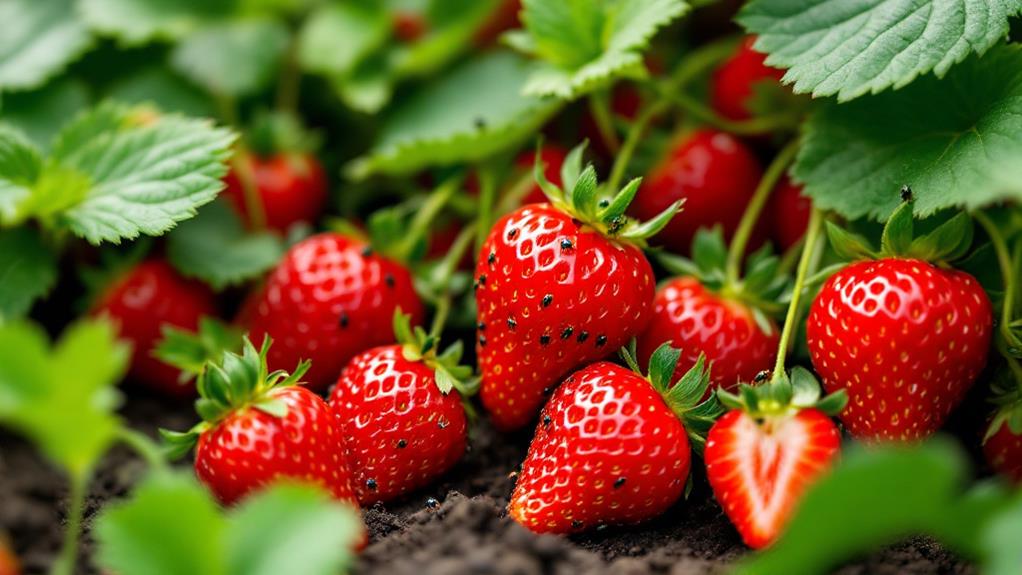
A successful strawberry harvest isn't just about planting and watering; managing pests and diseases is crucial for healthy everbearing strawberries. Common pests, such as slugs, aphids, and strawberry weevils, can wreak havoc if not addressed promptly. To effectively manage these threats, consider integrated pest management (IPM) strategies. This approach includes introducing beneficial insects like ladybugs to control aphid populations and using organic pesticides to minimize chemical use while protecting your plants.
Fungal diseases, including gray mold, anthracnose fruit rot, and phytophthora crown rot, pose significant risks to everbearing strawberries. Regular monitoring and preventive measures are key to keeping these diseases at bay. Proper watering techniques, such as avoiding overhead watering, can reduce the likelihood of fungal growth by improving air circulation and preventing excess moisture on leaves.
Additionally, selecting disease-resistant varieties is a proactive step in disease management. These varieties are bred to withstand common pathogens, reducing the frequency of disease outbreaks. Crop rotation is another effective practice, as it disrupts the life cycles of pests and diseases, promoting a healthier growing environment. By integrating these methods, you'll guarantee your everbearing strawberries thrive season after season.
Popular Varieties
Plunge into the world of everbearing strawberries by exploring some of the most popular types available. These types are known for their ability to produce fruit multiple times a year, making them a favorite among home gardeners and commercial growers. When selecting the right type, consider factors like flavor, high yield, and local climate conditions.
- Ozark Beauty: This type is renowned for its large fruit and impressive disease resistance, ensuring a reliable harvest. It's a great choice if you're looking for robust plants that can withstand common plant diseases.
- Seascape: Known for producing consistently sweet berries throughout the growing season, Seascape is perfect if you're after a dependable and tasty berry. Its flavor is a standout feature, making it a popular choice for fresh consumption and desserts.
- Albion: Favored for its high yield and excellent flavor, Albion stands out as a top choice for those who want both quantity and quality. Its adaptability to different climates adds to its appeal.
Don't overlook Quinault, recognized for its adaptability to different climates, especially cooler regions. It's known for producing large, flavorful berries, making it a versatile option in the everbearing strawberries lineup.
Benefits and Challenges
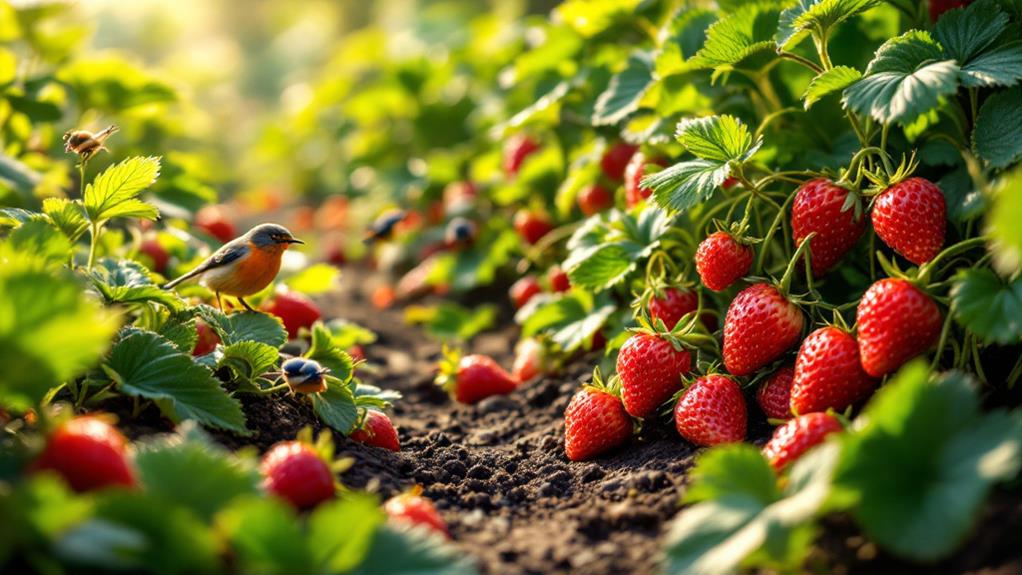
When you grow everbearing strawberries, you enjoy the benefit of multiple harvests throughout the growing season, providing fresh fruit in spring, midsummer, and late summer. This continuous supply is perfect for home gardeners who love the idea of having fresh strawberries available for months. Although everbearing strawberries produce smaller fruit compared to June-bearing varieties, they still offer a consistent yield that keeps your garden fruitful and lively.
These strawberries are adaptable, thriving in USDA Zones 3-10, which means you can grow them in different climates, though they might struggle in extreme heat. This could potentially affect total fruit production, so consider your local climate before planting. Regular maintenance, including diligent pest management and consistent watering, is essential to maximizing your yield. While this can be time-consuming, the effort pays off with healthy, productive plants.
The extended harvest season of everbearing strawberries necessitates a more complex preservation process. With continuous picking, you'll need to plan carefully to utilize and store the fruit effectively. Regardless of whether you're making jams, freezing, or enjoying them fresh, managing your harvests efficiently guarantees you make the most out of your growing season.
Community Insights
Exploring community insights reveals how crucial shared experiences are to successful everbearing strawberry cultivation. Engaging with fellow gardeners gives you access to invaluable knowledge about diverse everbearing strawberry varieties. You'll uncover discussions on unique flavor profiles and growth conditions that can inform your decisions. Many growers recommend planting these strawberries in late summer to early fall, which greatly improves root establishment and results in robust plants come spring.
One of the common topics you'll encounter in gardening forums is pest management. Community members frequently share organic methods and strategies, like introducing beneficial insects, to keep your strawberry patch thriving without harmful chemicals. Moreover, managing overgrown beds is a shared challenge. You can learn about effective pruning techniques and spacing strategies that optimize your yields.
Participating in strawberry picking events organized by local gardening clubs offers more than just a fun day out. These events foster social connections and knowledge sharing about planting strategies and cultivation practices. Here are three key takeaways from community interactions to improve your growing experience:
- Flavor profiles: Uncover unique tastes from different varieties.
- Organic methods: Learn sustainable pest management techniques.
- Pruning techniques: Master bed management for better yields.

